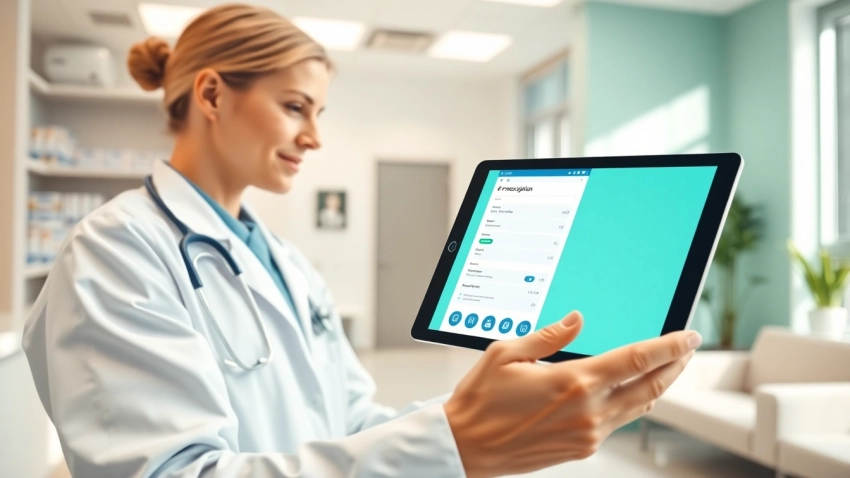
Effective Strategies for Choosing an E-Prescription App for Your Practice
Introduction to Choosing an E-Prescription App
The healthcare landscape is undergoing significant transformations, fueled by technological advancements that aim to enhance efficiency, reduce errors, and ultimately improve patient care. One of the areas experiencing this shift is the prescribing process, where choosing an eprescription app plays a crucial role in ensuring safe and streamlined medication management. In this comprehensive guide, we will explore what e-prescribing is, the benefits it provides for healthcare providers, key features to look for, and how to evaluate, implement, and benefit from an e-prescription app tailored to your practice’s needs.
What is E-Prescribing?
E-prescribing, or electronic prescribing, refers to the digital generation, transmission, and filling of medical prescriptions. This technology allows healthcare providers to send prescriptions directly to pharmacies electronically, eliminating the risks associated with handwritten prescriptions, such as illegible handwriting and lost paper prescriptions. E-prescribing systems can enhance the prescribing process by integrating with electronic health records (EHR) and providing access to essential patient information, medication history, and formulary data to ensure appropriate prescribing practices.
Benefits of E-Prescribing for Healthcare Providers
The implementation of e-prescribing offers numerous benefits to healthcare providers, streamlining workflows, enhancing patient safety, and improving overall efficiency. Some key advantages include:
- Increased accuracy: E-prescribing reduces the likelihood of medication errors caused by handwriting inconsistencies. Electronic scripts are clear and standardized.
- Time efficiency: Healthcare providers can save time with quick access to patient information and prescription history, allowing for faster prescription generation.
- Improved patient safety: E-prescribing systems often include built-in drug interaction checks and allergy alerts, helping to prevent adverse drug events.
- Convenience: Patients benefit from the convenience of having their prescriptions sent directly to their preferred pharmacies, often allowing for same-day pickup of medications.
- Cost savings: By having access to real-time formulary information, providers can prescribe more cost-effective medications, ultimately reducing healthcare expenditure.
Common Features to Look For
When selecting an e-prescription app, it’s essential to identify specific features that align with your practice needs. Here are some common features to consider:
- EHR integration: The app should seamlessly integrate with existing EHR systems to streamline workflows and minimize disruptions.
- User-friendly interface: Choose an app with an intuitive design that enables quick and straightforward navigation for healthcare providers.
- Medication management tools: Features such as medication lists, interaction checking, and allergy screening enhance patient safety.
- Customization options: Look for apps that allow you to tailor workflows according to your practice’s specific needs.
- Reporting capabilities: Comprehensive reporting features can support clinical audits and quality improvement initiatives.
Evaluating Your Practice’s Needs
Before diving into the technical aspects of e-prescription apps, it’s crucial to evaluate your practice’s unique needs. This assessment will guide your decision-making process and ensure that your chosen app aligns with your goals.
Identifying Workflow and Integration Challenges
The first step in evaluating your needs involves thoroughly assessing current workflows and identifying potential integration challenges. Consider the following questions:
- What are the current processes in place for prescribing medications?
- Where are the bottlenecks in your workflows?
- How does your existing EHR system fit into your prescribing practices?
- What challenges do your staff encounter when managing prescriptions?
By addressing these questions, you can develop a clearer picture of the challenges you face and the specific features your e-prescription app must address to provide a smooth transition and effective solutions.
Assessing Staff Training and Support
Implementing a new e-prescription app may require additional training for staff members. It’s essential to assess the level of training necessary and what support options are provided by the app vendor. Considerations should include:
- What training resources are available (e.g., webinars, tutorials, in-person training)?
- How can staff access ongoing support after the implementation of the app?
- Will there be opportunities for continued education as software updates are released?
A comprehensive training program will help minimize disruptions and ensure your staff can maximize the benefits of the new system from day one.
Determining Budget Constraints
Understanding your budget is critical when choosing an e-prescription app. Cost considerations may include:
- Initial costs: License fees, setup costs, and any additional fees for customization.
- Ongoing fees: Monthly subscriptions, per-prescription fees, and any maintenance costs.
- Indirect costs: Staff training and potential disruptions during the transition phase.
Weighing these elements against the expected benefits of enhanced workflows and improved patient safety will help you make an informed decision within your financial constraints.
Key Factors in Choosing an E-Prescription App
With a clearer assessment of your practice’s needs, you can begin to explore key factors that will influence your choice of an e-prescription app. Selecting a system that aligns with these criteria will contribute to successful implementation and integration into your practice.
Usability and User Interface Design
The usability of an e-prescription app is one of the most critical factors for its successful adoption. A well-designed user interface can significantly enhance staff efficiency, reduce frustration, and ensure that providers can quickly and accurately generate prescriptions. When assessing usability, consider:
- Ease of navigation: Can users effortlessly find the tools and features they need?
- Task efficiency: How many clicks are required to complete common tasks like prescribing or refilling medications?
- Visual clarity: Is the layout intuitive, and does it guide the user effectively?
Implementing a system that feels straightforward will lower the learning curve and encourage staff to utilize all available features fully.
Compliance and Security Considerations
Given the sensitive nature of healthcare data, compliance with healthcare regulations, such as HIPAA, is paramount. Verify that any e-prescription app you consider meets these standards for data protection and patient confidentiality. Important points to evaluate include:
- Encryption methods: Does the app utilize strong encryption for data in transit and at rest?
- Access controls: Are there user authentication and role-based access controls to safeguard sensitive information?
- Audit capabilities: Can the system provide audit trails for prescription activity to meet regulatory requirements?
Choosing an app with robust compliance measures helps protect your practice, your patients, and your data integrity.
Customer Reviews and Case Studies
Past performance can be a reliable indicator of an app’s effectiveness. Research customer reviews and case studies to understand how other practices have used the app and their experiences. Look for:
- Overall customer satisfaction: What do users report as strengths and weaknesses of the software?
- Specific use cases: How have similar practices benefitted from the app in question?
- App updates and improvements: Does the vendor show a commitment to enhancing their product based on user feedback?
Insight from actual users provides a well-rounded perspective that can greatly inform your decision-making process.
Implementing Your Chosen E-Prescription App
Once you’ve selected the ideal e-prescription app for your practice, the next step is successful implementation. The process requires strategic planning to ensure a smooth transition with minimal disruption to patient care.
Step-by-Step Implementation Process
A structured implementation strategy will help your practice adapt to the new system efficiently. Here’s a general framework you might follow:
- Initial planning: Lay out your goals, timelines, and key milestones for the implementation process.
- Set up the software: Work with the vendor to customize and install the software according to your practice’s workflow.
- Data migration: Migrate existing patient data safely into the new system, ensuring no loss of critical information.
- Training: Conduct comprehensive training sessions for all staff members and provide them with easy access to resources.
- Go live: Launch the e-prescription app and monitor its performance closely during the initial phase.
By following a clearly defined process, you can minimize the risks associated with implementing new technology.
Best Practices for Staff Training
Effective training is vital to the successful use of any new software. Here are some best practices to maximize the impact of your training sessions:
- Tailored training programs: Develop training content that addresses the specific roles and responsibilities of each staff member.
- Hands-on practice: Encourage staff to use the app in simulated environments to become comfortable with its features.
- Feedback sessions: Host regular sessions where staff can share their challenges and feedback on the app, allowing for further improvement and customization.
Well-designed training programs will greatly enhance user satisfaction and app adoption rates.
Monitoring Performance and User Feedback
After the implementation, continuous monitoring of the e-prescription app’s performance is necessary to ensure it meets your practice’s expectations. Key practices include:
- Tracking usage: Regularly review app usage metrics to identify any underutilized features that could enhance efficiency.
- Gathering feedback: Conduct regular surveys and meetings to solicit feedback from users to identify pain points.
- Ongoing support: Maintain a relationship with the vendor to address ongoing concerns and keep the app up-to-date with the latest features and security measures.
By investing in ongoing evaluation, you can ensure that the e-prescription app continues to support the needs of your practice effectively.
Future Trends in E-Prescribing
The landscape of healthcare technology is continuously evolving, and so too is e-prescribing. Keeping an eye on emerging trends will help your practice stay ahead of the curve and remain competitive.
Technological Innovations in E-Prescribing
As technology advances, so do the capabilities of e-prescribing systems. Some promising innovations to watch for include:
- Artificial intelligence: The integration of AI can improve clinical decision support, predicting potential medication interactions and offering suggestions based on a patient’s history.
- Mobile applications: Growing reliance on mobile services means that more e-prescribing solutions are being developed for use on handheld devices, enhancing convenience for providers.
- Interoperability: Efforts are increasing toward creating systems that communicate across different platforms, facilitating easier sharing of prescription data.
By keeping updated on these innovations, your practice can leverage new technologies for improved patient care.
The Impact of Telemedicine
The rise of telemedicine has transformed how healthcare providers interact with patients, making it imperative for e-prescribing systems to adapt. Key impacts include:
- Remote prescribing: E-prescribing allows telehealth providers to prescribe medications during virtual appointments, ensuring seamless patient care irrespective of location.
- Increased demand for convenience: Patients expect faster and more accessible healthcare services, putting pressure on e-prescribing solutions to accommodate complex workflows.
- Integration with telehealth platforms: E-prescribing apps must integrate well with telehealth services for a cohesive patient experience, minimizing the chance of errors.
Adapting your e-prescribing practices to fit this new environment will be crucial for maintaining compliance and enhancing the patient experience.
Regulatory Changes to Watch
Regulatory conditions surrounding e-prescribing are in constant flux, often influenced by public health needs and technological advancements. Important areas of focus include:
- Mandates for e-prescribing: Some states have begun enacting laws that require e-prescribing for certain medications, especially controlled substances.
- Data privacy legislation: Changes in HIPAA and other privacy regulations can affect how patient data is managed within e-prescribing systems.
- Reimbursements and incentives: Understanding how e-prescribing impacts billing and reimbursements can present financial opportunities or challenges for practices.
Staying informed about these regulations will help your practice navigate compliance and avoid potential pitfalls while maximizing the benefits of e-prescribing.












Leave a Reply